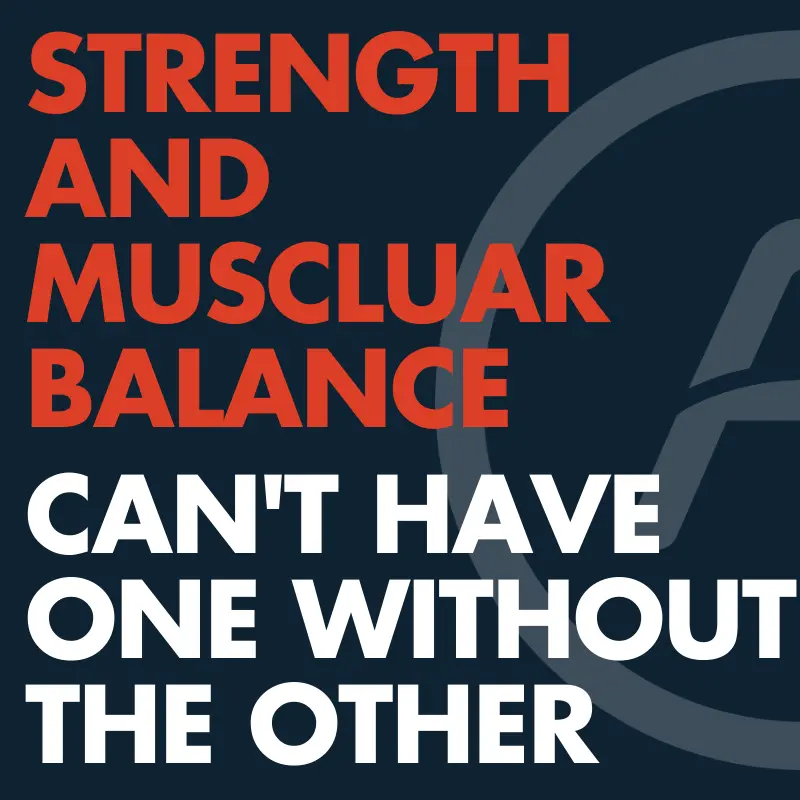Strength and Balance
You need to have both.
A few years back we worked with a company called Active Life. A large focus for their company was to make Coaches on par with Doctors.
The company is composed of Doctors, Physical Therapists, Chiropractors, etc., so they know what it takes. They want to get everyday fitness coaches to a higher level of knowledge because they understand that if they keep people on track and safe from the start, many people will/could eliminate the need for doctors in their future.
Healthy people get sick less...in a nutshell.
Unfortunately, it does not take the same level of schooling to become a coach.
Over the years we have done numerous continuing-ed classes, seminars, certifications. Coach Ariel is one of, at the time, 800 Level 3 CrossFit Coaches...in the WORLD!
Anyway, one of the primary things they covered with us was what strength numbers a person should be able to hit to have a balanced body. Meaning all the muscle groups are balanced or equal to each other.
How heavy they are is irrelevant. How they compare to each other is crucial for health and injury prevention.
Let’s dive in!
Let's begin with the lower body, the/your max Deadlift specifically.
First, you need to know that this does not need to be a 1 Rep Max, it can be your best 1-10 reps.
Completing a 1RM is potentially dangerous if you are not accustomed to it. It tests your body at its absolute physical limits and if you are new to lifting, it is difficult to truly know if the weight hit is a real max...or just really heavy. Something only experience can tell you.
It is easier to tell if you can do another rep or not, so we set up a weight you know you can hit 2-3 reps and see if we can safely squeak out 5!
There, all the explaining to hit 5 Deadlift reps at (let’s say) 200 pounds.
What does this tell us? A lot.
Based on this number, we know approximately what you should be able to hit for your Back Squat, Front Squat, front rack Box Step Up, and more to be balanced.
With a 5RM Deadlift at 200 lbs (100%)...you should be able to hit 5 reps of:
Back Squat - 160lbs (80% of DL)
Front Squat - 136lbs (68%)
Front rack Box Step up - 66lbs (33%)
Single leg Deadlift - 90lbs (45%)
Single arm Farmers Carry - 100lbs (50% weight for 10ft per rep of DL)
Why is any of this important?
We know a balanced body works better. If your hamstrings are balanced with your quads, you should have fewer knee and back problems throughout your life.
If we know you can step up the same weight and reps on each leg, we know you should have fewer hip and knee problems. I’ll get to the upper body shortly.
So, testing and knowing these numbers allows us to find gaps or weaknesses in your body.
How heavy the numbers are…is almost completely unimportant. The only lifelong testament (I’ve heard) to having a higher back squat is: “The higher the squat, the easier it is for someone to get up and down (to a chair or toilet), which comes in very handy when you are 80 years old.” Simply meaning the more you can squat, the easier it is on your body to move its own weight, and therefore getting up and down takes less of a toll. Or, one more...if you are stronger, you shouldn’t need help to poop when you are 80!
We believe knowing these numbers, and how it coincides with the movement screening we had most of you do when starting with us, is important.
Knowing both of the tests/screenings allows us to recommend different movements, different stretches, different reps, different ranges of motion, etc.
The upper body numbers are as follows:
- Max Strict Pull-ups for reps
- Max Strict Dips = same as pull-ups
- Max Single arm Upright Row at 33% body weight (BW) = same reps as pull-ups
- Max Single arm Overhead Press at 33% BW = same reps as pull-ups
There is, of course, many other layers to this puzzle, like:
- How the movement screening affects the lifts you should perform?
- What to do if strict pull-ups are still a distant future?
- What does performing 20 reps at 50% of your max’s tell us?
- What can be done if you have tendonitis or tendinitis?
- What if one arm/side is stronger than the other?
All questions Ariel, Matt, and Ryan can usually answer.
We are, of course, NOT Doctors. If you do have knee pain, we may be able to provide an educated guess but nothing further. A Doctor with advanced imaging tools can provide a far clearer answer.
What we are saying we can do is help you work around it, modify appropriately, allowing you to keep making progress.
At the end of the day, we want to build better-built humans and do it safely. We know these numbers will help us get you there and plan to test them very soon. Stay tuned!
